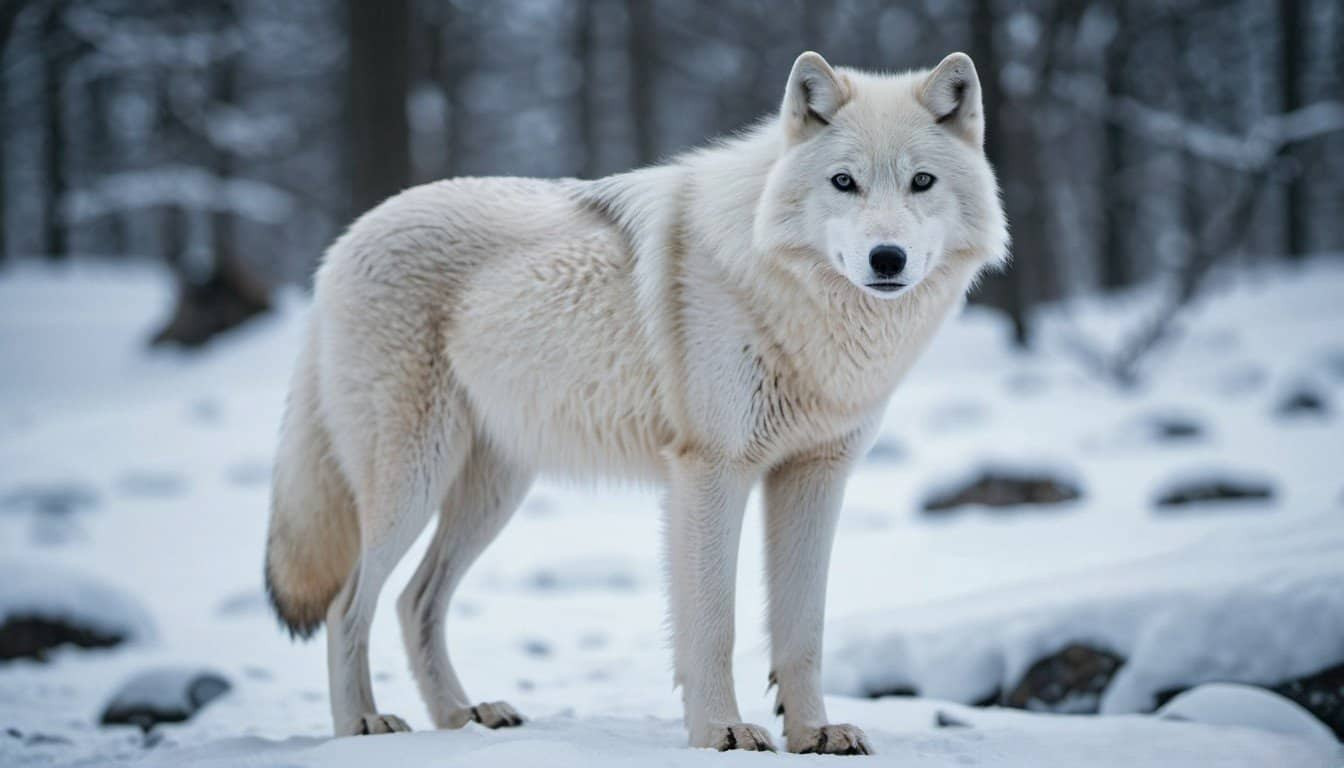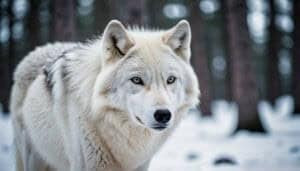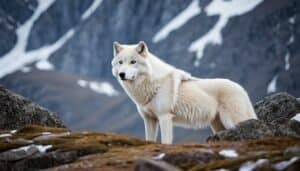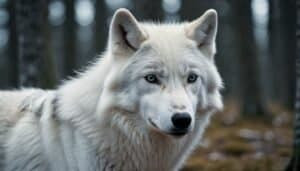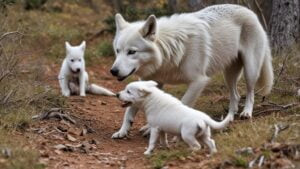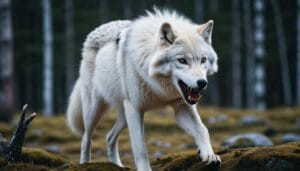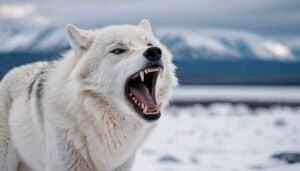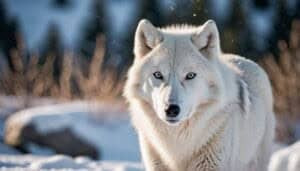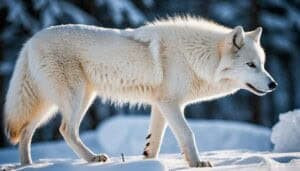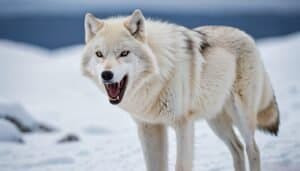Introduction
The Arctic wolf’s digestive system is uniquely adapted to process a diet primarily composed of meat. This article delves into the various stages of digestion, from the initial breakdown in the stomach to nutrient absorption in the intestines. We will explore the key organs involved, how the wolf’s system adapts to a high-protein diet, and the impact of their diet on overall health
Additionally, comparisons with other canids, handling bones, and common digestive issues will be discussed to provide a comprehensive understanding of this remarkable predator’s digestive process
The Arctic Wolf’s Digestive System
The digestive system of the Arctic wolf is a highly specialized mechanism that enables the efficient processing of a meat-heavy diet. From the moment food enters the wolf’s mouth until it exits as waste, each part of the digestive system plays a crucial role in breaking down food, absorbing nutrients, and eliminating waste
Overview of the Digestive Process
The digestive process in Arctic wolves begins with ingestion and ends with excretion. The primary stages include:
Ingestion: The wolf consumes its prey, often in large chunks. Arctic wolves primarily prey on caribou and muskoxen, but they also eat smaller animals like Arctic hares and lemmings
Their strong jaws and sharp teeth are adapted to tear through flesh and crunch bones, allowing them to consume almost every part of their prey
Mechanical Breakdown: Teeth and jaw muscles break the food into smaller pieces. The Arctic wolf’s dentition includes large canines for gripping and tearing flesh, carnassial teeth for shearing meat, and molars for grinding
This mechanical breakdown is essential for increasing the surface area of the food, making it easier for digestive enzymes to act upon it
Chemical Breakdown: Digestive enzymes and stomach acids further decompose the food. The stomach of an Arctic wolf secretes hydrochloric acid and pepsinogen, which convert to pepsin in the acidic environment, breaking down proteins into peptides
Additionally, the pancreas secretes enzymes like amylase, lipase, and proteases into the small intestine to continue the chemical digestion of carbohydrates, fats, and proteins
Nutrient Absorption: Nutrients are absorbed mainly in the small intestine. The small intestine is lined with villi and microvilli, which increase the surface area for absorption. Here, amino acids, simple sugars, fatty acids, and glycerol are absorbed into the bloodstream
The efficiency of nutrient absorption is critical for the Arctic wolf’s survival, especially given the harsh and nutrient-scarce environment in which they live
Waste Elimination: Indigestible parts are expelled as feces. The remaining indigestible material and waste products pass into the large intestine, where water is reabsorbed, and the waste is compacted into feces
The Arctic wolf’s feces can contain bones, fur, and other indigestible parts of their prey, which are often visible to the naked eye. This process helps maintain the wolf’s energy balance and overall health
Key Organs Involved
The main organs involved in the Arctic wolf’s digestive process are:
Mouth: The mouth is where ingestion and initial mechanical breakdown occur. Arctic wolves use their sharp incisors and powerful canines to grasp and tear their prey into smaller, manageable pieces
Salivary glands in the mouth secrete saliva, which contains enzymes that begin the digestion of carbohydrates, although this plays a minor role in carnivorous diets
Esophagus: The esophagus is a muscular tube that transports food to the stomach through a series of coordinated contractions known as peristalsis. The esophagus ensures that food moves efficiently from the mouth to the stomach, regardless of the wolf’s body position
Stomach: The stomach produces acids and enzymes to chemically break down food. The stomach’s acidic environment, primarily due to hydrochloric acid, helps denature proteins and activate digestive enzymes like pepsin
The stomach also mechanically churns the food, mixing it with gastric juices to form a semi-liquid substance called chyme
Small Intestine: The small intestine is the primary site for nutrient absorption. It is divided into three sections: the duodenum, jejunum, and ileum. The duodenum receives chyme from the stomach along with bile from the liver and digestive enzymes from the pancreas
The jejunum and ileum are lined with villi and microvilli that maximize nutrient absorption. Here, nutrients like amino acids, simple sugars, fatty acids, and glycerol are absorbed into the bloodstream
Large Intestine: The large intestine absorbs water and forms feces. It includes the cecum, colon, and rectum. In the colon, water and electrolytes are reabsorbed, and the remaining waste is compacted into feces
The rectum stores feces until they are expelled from the body during defecation. The large intestine plays a crucial role in maintaining the wolf’s fluid and electrolyte balance
Liver and Pancreas: The liver and pancreas produce bile and enzymes essential for digestion. The liver produces bile, stored in the gallbladder and released into the small intestine, where it emulsifies fats, making them easier to digest
The pancreas secretes a variety of enzymes, including amylase, lipase, and proteases, into the small intestine. These enzymes aid in the digestion of carbohydrates, fats, and proteins, respectively. Additionally, the pancreas produces bicarbonate to neutralize stomach acid in the chyme, providing an optimal pH for enzymatic activity in the small intestine
Digestive Timeline for Meat
The time it takes for an Arctic wolf to digest meat can vary based on several factors. Here is a breakdown of the typical timeline:
Phases of Digestion
Initial Breakdown (0-1 hours): Chewing and swallowing lead to the initial breakdown of food. In the mouth, Arctic wolves use their strong teeth to tear food into smaller pieces, which is then mixed with saliva containing enzymes like amylase
This prepares the food for smooth passage through the esophagus. Peristaltic movements in the esophagus transport the food bolus to the stomach
Stomach Digestion (1-4 hours): Food is mixed with stomach acids and enzymes. Upon entering the stomach, the food is subjected to a highly acidic environment, primarily due to hydrochloric acid
This acid not only helps denature proteins but also activates pepsinogen to pepsin, an enzyme crucial for protein digestion. The stomach muscles rhythmically contract, mixing the food with digestive juices to form chyme, a semi-liquid mixture that gradually moves into the small intestine
Small Intestine Absorption (4-10 hours): Nutrients are absorbed into the bloodstream. The chyme enters the small intestine, starting with the duodenum, where it is mixed with bile from the liver and digestive enzymes from the pancreas. Bile emulsifies fats, while pancreatic enzymes continue the breakdown of proteins, fats, and carbohydrates
The lining of the small intestine, covered with villi and microvilli, facilitates the absorption of nutrients into the bloodstream. This absorption primarily occurs in the jejunum and ileum sections of the small intestine
Large Intestine Processing (10-24 hours): Remaining water and nutrients are absorbed, and waste is formed. The indigestible residue and unabsorbed nutrients enter the large intestine. Here, water and electrolytes are reabsorbed, transforming the liquid chyme into more solid feces
The colon hosts beneficial bacteria that further break down some of the remaining nutrients and produce vitamins like vitamin K. The rectum stores feces until they are expelled from the body during defecation
Factors Affecting Digestion Speed
Size of the Meal: Larger meals take longer to digest. When an Arctic wolf consumes a substantial amount of food, its stomach and intestines need more time to break down the complex proteins, fats, and carbohydrates
This increased volume also requires more extensive mechanical and chemical processing, slowing the overall digestion process
Type of Meat: Lean meats may digest faster than fattier cuts. The fat content in the meat affects digestion speed; lean meats, being lower in fat, are broken down more quickly than fattier cuts
Fats take longer to digest because they require emulsification by bile and extensive enzyme activity for breakdown and absorption
Wolf’s Health: Healthier wolves typically have more efficient digestion. A wolf in good health with a robust digestive system can process food more effectively
Factors such as age, presence of parasites, or digestive disorders can impede the digestive process, leading to slower digestion and nutrient absorption
Activity Level: Active wolves may digest food more quickly. Physical activity stimulates the digestive system, increasing blood flow to the digestive organs and enhancing the efficiency of digestive processes
Active wolves, with higher metabolic rates, often experience faster digestion compared to more sedentary individuals
Understanding the Arctic wolf’s digestive system provides insight into how these predators thrive in harsh environments. Each stage of the process is optimized for maximum nutrient extraction, enabling the wolf to maintain its health and energy levels in the challenging Arctic conditions
Role of the Stomach in Meat Digestion
The stomach of the Arctic wolf plays a pivotal role in the initial stages of meat digestion. It acts as a reservoir for ingested food, initiating both mechanical and chemical digestion. This process ensures that the nutrients from the meat are efficiently broken down and prepared for absorption in the intestines
Breakdown of Meat
When an Arctic wolf consumes its prey, the food enters the stomach where it undergoes significant breakdown:
Mechanical Breakdown: The stomach muscles contract rhythmically to churn the food, breaking it into smaller, more manageable pieces. This mechanical action increases the surface area of the food, making it more accessible to digestive enzymes
Chemical Breakdown: The stomach lining secretes gastric juices, which contain hydrochloric acid and digestive enzymes. These components work together to break down the protein structures in the meat, turning solid food into a semi-liquid mixture known as chyme
Secretion of Digestive Enzymes
The stomach’s role in digestion is heavily reliant on the secretion of various enzymes and acids:
Hydrochloric Acid (HCl): This acid creates an acidic environment in the stomach, which is essential for the activation of digestive enzymes and the breakdown of muscle fibers and connective tissues in the meat. The low pH also helps to kill any harmful bacteria present in the food
Pepsin: This enzyme is specifically tasked with breaking down proteins into smaller peptides. Pepsin is initially secreted in an inactive form called pepsinogen, which is activated by the acidic environment of the stomach
Gastric Lipase: Although most fat digestion occurs in the small intestine, gastric lipase begins the process in the stomach by breaking down triglycerides into free fatty acids and glycerol
Intrinsic Factor: This glycoprotein is essential for the absorption of vitamin B12 later in the digestive process. While not directly involved in meat breakdown, its presence is crucial for overall digestive health
The stomach’s environment is carefully regulated to maximize digestive efficiency. The combination of mechanical and chemical processes ensures that the ingested meat is sufficiently broken down, allowing the small intestine to effectively absorb nutrients
This initial stage of digestion is vital for the Arctic wolf’s ability to thrive on a meat-heavy diet, providing the energy and nutrients needed to sustain its active lifestyle in a challenging environment
Nutrient Absorption in the Small Intestine
After the initial breakdown of food in the stomach, the semi-liquid chyme moves into the small intestine, where the majority of nutrient absorption occurs. The small intestine is a highly specialized organ that plays a crucial role in extracting essential nutrients from the food consumed by the Arctic wolf
Enzyme Functionality
The small intestine relies on a variety of enzymes to continue the digestion process. These enzymes break down complex molecules into simpler forms that can be easily absorbed:
Pancreatic Enzymes
The pancreas secretes several vital enzymes into the small intestine, playing a crucial role in the digestive process of Arctic wolves. These enzymes include:
Trypsin and Chymotrypsin: These enzymes further break down proteins into smaller peptides and amino acids. Trypsinogen and chymotrypsinogen, inactive precursors of trypsin and chymotrypsin respectively, are secreted by the pancreas and activated in the small intestine
Trypsin activates chymotrypsinogen to chymotrypsin, and both enzymes work together to cleave peptide bonds within proteins, facilitating the breakdown of complex proteins into absorbable units
Pancreatic Lipase: This enzyme continues the digestion of fats by breaking down triglycerides into free fatty acids and glycerol. Pancreatic lipase, along with colipase (a coenzyme), works in the presence of bile to efficiently digest dietary fats
This process is essential for Arctic wolves, whose diet consists largely of fatty prey, providing them with the necessary energy and nutrients for survival in their harsh environment
Amylase: While not as crucial for a carnivorous diet, amylase breaks down carbohydrates into simple sugars. Although Arctic wolves consume minimal carbohydrates, pancreatic amylase is still secreted and acts on any starches present in their diet
This enzyme hydrolyzes starch into maltose and other oligosaccharides, which are further broken down into glucose by other enzymes in the small intestine
Bile
Produced by the liver and stored in the gallbladder, bile is a crucial component in the digestion of fats. When food enters the small intestine, bile is released into the duodenum. Bile contains bile salts, which emulsify fats, breaking them down into smaller droplets
This emulsification increases the surface area of fats, making them more accessible to digestive enzymes, specifically pancreatic lipase. The action of bile is essential for the efficient digestion and absorption of dietary fats, providing Arctic wolves with the energy reserves needed for their active lifestyle in the harsh Arctic environment
Brush Border Enzymes
The lining of the small intestine contains microvilli that produce enzymes known as brush border enzymes. These enzymes include maltase, sucrase, and peptidases, which play a critical role in the final stages of digestion, converting carbohydrates and proteins into absorbable units:
Maltase: Maltase breaks down maltose, a disaccharide, into two glucose molecules. This enzyme is essential for the digestion of starches and glycogen, which may be present in small amounts in the diet of Arctic wolves, particularly if they consume the stomach contents of herbivorous prey
Sucrase: Sucrase hydrolyzes sucrose into glucose and fructose. While sucrose is not a significant component of a carnivorous diet, any ingestion of plant material that contains sucrose can be efficiently processed by this enzyme
Peptidases: Peptidases break down peptides into individual amino acids. These enzymes include aminopeptidases, carboxypeptidases, and dipeptidases, which act on the peptide bonds within small peptide chains, completing the protein digestion process initiated in the stomach and continued by pancreatic enzymes
This breakdown is essential for the absorption of amino acids, which are crucial for the growth, repair, and maintenance of the Arctic wolf’s body tissues
Absorption of Proteins and Fats
The small intestine is uniquely adapted to maximize the absorption of proteins and fats, which are critical components of the Arctic wolf’s diet. This adaptation ensures that these essential nutrients are efficiently utilized to maintain the wolf’s health and energy levels in the demanding Arctic environment
Protein Absorption
Protein digestion begins in the stomach and continues in the small intestine, where it is broken down into amino acids and small peptides by enzymes like trypsin, chymotrypsin, and brush border peptidases
The small intestine’s lining is covered with villi and microvilli, which increase the surface area for absorption. Amino acids and small peptides are absorbed through the epithelial cells of the small intestine via active transport mechanisms
Once inside the cells, peptides are further broken down into amino acids, which then enter the bloodstream and are transported to various tissues for protein synthesis, growth, and repair
Fat Absorption
Fat digestion primarily occurs in the small intestine with the help of bile and pancreatic lipase. Bile salts emulsify fats, breaking them down into smaller droplets, which increases their surface area for the action of pancreatic lipase
This enzyme hydrolyzes triglycerides into free fatty acids and monoglycerides. These smaller molecules form micelles with bile salts, which transport them to the brush border of the intestinal epithelial cells. Inside the cells, fatty acids and monoglycerides are reassembled into triglycerides and packaged into chylomicrons
Chylomicrons enter the lymphatic system through lacteals, small lymph vessels in the villi, and eventually reach the bloodstream, where they are distributed to tissues for energy production or storage
The small intestine’s ability to effectively absorb proteins and fats ensures that the Arctic wolf receives the necessary nutrients to maintain its health and energy levels, supporting its survival in the harsh Arctic environment
Adaptations to a High-Protein Diet
The Arctic wolf’s digestive system has evolved to efficiently process a diet primarily composed of meat. This high-protein diet demands specific adaptations that ensure the wolf can extract the maximum amount of nutrients from its food while minimizing waste
These adaptations are crucial for survival in the Arctic’s harsh conditions, where food can be scarce, and energy conservation is essential
Metabolic Adjustments
The Arctic wolf has several metabolic adjustments that allow it to thrive on a high-protein diet:
Efficient Protein Utilization
Amino Acid Metabolism: Arctic wolves have a high rate of protein turnover, which allows them to utilize amino acids effectively for energy, growth, and repair. This efficiency is vital for maintaining muscle mass and overall health, especially during periods when food is scarce
Nitrogen Balance: Wolves maintain a positive nitrogen balance, meaning they retain more nitrogen than they excrete. This balance is crucial for synthesizing proteins and other nitrogen-containing compounds necessary for survival
Increased Gluconeogenesis
Energy from Protein: Gluconeogenesis is the process of producing glucose from non-carbohydrate sources, such as amino acids. This process is essential for Arctic wolves, as their diet lacks significant carbohydrates. Their liver is adapted to convert amino acids into glucose, ensuring a steady supply of energy
Efficiency in Nutrient Extraction
The Arctic wolf’s digestive system is highly efficient at extracting nutrients from meat, ensuring that little is wasted. This efficiency is crucial for survival in the harsh Arctic environment, where food can be scarce and every meal counts:
Enhanced Digestive Enzyme Production
Increased Enzyme Activity: The stomach and pancreas of Arctic wolves produce higher levels of digestive enzymes compared to other animals. This increased enzyme activity allows for rapid and thorough breakdown of proteins and fats
Adaptable Enzyme Production: Wolves can adjust their enzyme production based on their diet’s composition. This adaptability ensures they can efficiently digest different types of prey
Intestinal Adaptations
Villi and Microvilli Density: The small intestine of Arctic wolves has a high density of villi and microvilli, increasing the surface area for nutrient absorption. This adaptation maximizes the amount of nutrients absorbed from each meal
Rapid Transit Time: Despite the efficient absorption, the transit time through the digestive system is relatively quick. This rapid processing prevents the buildup of waste products and reduces the risk of digestive issues
Fat Storage
Energy Reserves: Arctic wolves have the ability to store excess fat in their bodies. This fat serves as an energy reserve during periods when food is scarce, ensuring they can survive the harsh Arctic winters
These adaptations to a high-protein diet allow the Arctic wolf to efficiently process and utilize the nutrients from their prey. The ability to convert proteins into usable energy, coupled with an efficient digestive system, ensures that Arctic wolves remain healthy and energetic even in the most challenging environments
This high level of efficiency is a testament to the evolutionary adaptations that have allowed the Arctic wolf to become a top predator in its ecosystem
Function of the Large Intestine
The large intestine plays a crucial role in the final stages of digestion for the Arctic wolf. It is responsible for absorbing water and electrolytes from the indigestible food residue, forming and storing feces, and facilitating the elimination of waste
Although the large intestine does not contribute significantly to nutrient absorption, its functions are essential for maintaining overall digestive health
Water Absorption
One of the primary functions of the large intestine is to absorb water from the indigestible food matter, playing a critical role in maintaining the Arctic wolf’s fluid balance and overall hydration:
Rehydration of the Body
Water Reabsorption: As the chyme passes through the large intestine, water is reabsorbed into the bloodstream. This process helps to maintain the body’s hydration levels, which is particularly important in the Arctic environment where water may be scarce
Electrolyte Balance: Along with water, the large intestine also absorbs essential electrolytes, such as sodium and potassium. These electrolytes are vital for maintaining cellular function and overall fluid balance
Formation of Stool
Solidifying Waste: The absorption of water from the chyme results in the formation of solid feces. This process is necessary to prevent dehydration and ensure that waste is excreted in a manageable form
Bacterial Fermentation: The large intestine contains a diverse population of bacteria that ferment undigested carbohydrates. This fermentation process produces gases and short-chain fatty acids, which can be used as an additional energy source
Formation of Feces
The large intestine is responsible for the final processing and storage of waste before it is excreted:
Compaction
Waste Concentration: As water is absorbed, the remaining waste material becomes more concentrated. This compaction is essential for forming solid feces that can be easily excreted
Mucus Production: The lining of the large intestine secretes mucus, which lubricates the feces and facilitates its passage through the colon
Storage
Rectal Storage: The formed feces are stored in the rectum until the Arctic wolf is ready to eliminate waste. This storage capacity allows the wolf to control when and where it defecates, which can be crucial for avoiding predators and maintaining territory
Defecation Reflex: When the rectum is full, stretch receptors in the rectal walls trigger the defecation reflex. This reflex involves a coordinated contraction of the rectal muscles and relaxation of the anal sphincters, allowing the feces to be expelled
The large intestine’s efficient absorption and waste management processes ensure that the Arctic wolf maintains its hydration and electrolyte balance
These functions are vital for the wolf’s overall health, particularly in the demanding Arctic environment where food and water sources can be unpredictable. By effectively managing waste, the large intestine plays a key role in supporting the Arctic wolf’s survival and well-being
Comparing the Digestive Systems of Arctic Wolves and Other Canids
The Arctic wolf’s digestive system shares many similarities with other canids, but it also exhibits unique adaptations that allow it to thrive in the extreme conditions of the Arctic
Comparing the digestive systems of Arctic wolves with those of other canids, such as domestic dogs and gray wolves, highlights these adaptations and provides a deeper understanding of their dietary and environmental requirements
Similarities and Differences
The digestive systems of Arctic wolves and other canids have several fundamental similarities due to their shared evolutionary history. However, key differences arise from the distinct environmental pressures and dietary habits of these species
Similarities
Basic Digestive Anatomy: All canids, including Arctic wolves, have a similar basic digestive anatomy, comprising the mouth, esophagus, stomach, small intestine, and large intestine. This common structure reflects their carnivorous heritage
Enzyme Production: Canids produce similar digestive enzymes, such as pepsin, trypsin, and lipase, which are essential for breaking down proteins and fats in their diet
Microbiota: The gut microbiota of canids is relatively similar, with a predominance of bacteria that aid in the digestion of proteins and fats
Differences
Dietary Adaptations: Arctic wolves primarily consume large prey animals, such as caribou and musk oxen, which results in a diet high in protein and fat. In contrast, domestic dogs have a more varied diet that can include grains and vegetables
Fasting and Feasting: Arctic wolves have adapted to periods of feast and famine. They can consume large amounts of food when prey is abundant and survive long periods without eating, thanks to their efficient fat storage and metabolic adjustments. Domestic dogs, on the other hand, are typically fed regularly
Stomach Capacity: The stomach capacity of Arctic wolves is larger relative to their body size compared to domestic dogs. This adaptation allows them to consume large meals and store food during times of scarcity
Evolutionary Adaptations
The Arctic wolf’s digestive system has evolved specific adaptations to meet the demands of its harsh environment. These evolutionary changes distinguish it from other canids and underscore its specialization for a meat-based diet
Thermoregulation
High Fat Diet: The high-fat diet of Arctic wolves not only provides energy but also supports thermoregulation. Fat metabolism generates heat, which is crucial for maintaining body temperature in the cold Arctic climate
Protein Metabolism
Efficient Protein Utilization: Arctic wolves have evolved to efficiently metabolize protein for energy. This adaptation is essential for survival during times when their diet consists almost exclusively of lean meat
Reduced Urea Production: To conserve water, Arctic wolves produce less urea relative to other canids. This adaptation minimizes water loss through urine, which is vital in an environment where liquid water may be scarce
Behavioral Adaptations
Hunting Strategies: The hunting strategies of Arctic wolves are adapted to the open tundra. They often hunt in packs to take down large prey, ensuring a stable food supply. This contrasts with the more varied hunting and scavenging behaviors of other canids
These evolutionary adaptations highlight the Arctic wolf’s specialization for its environment and diet. While sharing many characteristics with other canids, the unique features of the Arctic wolf’s digestive system enable it to efficiently process a high-protein, high-fat diet and survive in one of the planet’s most challenging habitats
Handling Bones in the Digestive System
Bones are a significant part of the Arctic wolf’s diet, providing essential nutrients such as calcium and phosphorus. The ability to digest and utilize bones is a critical adaptation for these predators, allowing them to extract maximum nutrition from their prey
The Arctic wolf’s digestive system is uniquely equipped to handle bones, breaking them down efficiently and minimizing potential risks
Breakdown and Utilization
Arctic wolves have developed several mechanisms to break down and utilize bones:
Mechanical Breakdown
Powerful Jaw Muscles: Arctic wolves possess strong jaw muscles that enable them to crush and break bones into smaller pieces. This mechanical breakdown is the first step in making the bones digestible
Sharp Teeth: Their teeth, especially the carnassials, are adapted for shearing and cracking bones. These specialized teeth facilitate the initial breakdown of bones into more manageable fragments
Chemical Breakdown
Stomach Acidity: The stomach of the Arctic wolf produces highly acidic gastric juices with a pH low enough to dissolve bone material. This acidity not only breaks down the bone but also kills any harmful bacteria that may be present
Enzymatic Action: Enzymes like pepsin also play a role in breaking down the collagen matrix within bones, further aiding in the digestion process
Nutrient Absorption
Calcium and Phosphorus: Once the bones are broken down, the minerals, including calcium and phosphorus, are absorbed in the small intestine. These nutrients are crucial for maintaining strong bones and teeth, muscle function, and overall health
Bone Marrow: Bones contain marrow, which is rich in fats and other nutrients. The digestive system efficiently extracts and absorbs these nutrients, providing a vital energy source
Risks and Benefits
While bones are a valuable nutrient source, they also pose certain risks. However, the Arctic wolf’s digestive system and behavior mitigate these risks effectively:
Benefits
Nutrient-Rich: Bones provide essential minerals and marrow, which are critical for the Arctic wolf’s health, especially in nutrient-scarce environments
Dental Health: Chewing bones helps maintain dental health by scraping off plaque and preventing periodontal disease
Risks
Obstructions and Injuries: Large or sharp bone fragments can potentially cause obstructions or injuries in the digestive tract. However, Arctic wolves typically avoid these risks through their eating habits and digestive adaptations
Gastrointestinal Issues: Consuming excessive bone material can lead to gastrointestinal issues such as constipation or perforation. Arctic wolves manage this by balancing their intake of bones with other parts of their prey
Mitigation Strategies
Selective Eating: Arctic wolves are selective eaters, often consuming softer bones and marrow while discarding larger, harder bones. This behavior reduces the risk of digestive complications
Efficient Digestion: The highly acidic environment of their stomachs ensures that most bone material is broken down efficiently, minimizing the chance of blockages or injuries
By efficiently breaking down and utilizing bones, the Arctic wolf’s digestive system ensures that these predators derive maximum benefit from their prey. This ability is crucial for their survival in the harsh Arctic environment, where every available nutrient must be utilized effectively
Common Digestive Issues
Despite their highly adapted digestive systems, Arctic wolves can still face various digestive issues. These problems can arise from environmental factors, dietary imbalances, or health conditions
Understanding these issues is essential for wildlife biologists and conservationists working to ensure the health and survival of Arctic wolves in their natural habitat
Symptoms and Causes
Common digestive issues in Arctic wolves can manifest through various symptoms and have multiple underlying causes:
Symptoms
Vomiting: Frequent vomiting can indicate gastrointestinal distress, infections, or ingestion of harmful substances
Diarrhea: Loose or frequent stools may signal infections, dietary imbalances, or parasites
Constipation: Difficulty in passing stool can result from inadequate hydration, excessive bone consumption, or obstructions
Bloating and Discomfort: Swelling of the abdomen and signs of pain may suggest blockages, gas buildup, or gastrointestinal infections
Weight Loss: Unintended weight loss can indicate malabsorption issues, chronic infections, or parasites
Causes
Dietary Imbalances: An imbalanced diet lacking in essential nutrients can lead to digestive problems. While Arctic wolves primarily consume meat, an overconsumption of bones or a lack of variety in their diet can cause issues
Parasites: Intestinal parasites such as worms can cause significant digestive problems, including diarrhea, malnutrition, and weight loss
Infections: Bacterial, viral, or fungal infections can disrupt the normal digestive processes, leading to vomiting, diarrhea, and general discomfort
Environmental Toxins: Ingesting toxins present in the environment, such as contaminated water or prey, can cause acute or chronic digestive issues
Prevention and Treatment
Preventing and treating digestive issues in Arctic wolves involves a combination of environmental management, dietary monitoring, and medical intervention:
Prevention
Balanced Diet: Ensuring that Arctic wolves have a balanced diet that includes muscle meat, organs, and some bones can help prevent digestive issues. In the wild, this balance is typically achieved through natural predation on a variety of prey
Regular Health Checks: Routine health monitoring by wildlife biologists can help detect early signs of digestive issues. This includes checking for parasites and ensuring that the wolves are consuming a healthy diet
Clean Environment: Maintaining a clean environment free from contaminants and toxins is crucial. This includes ensuring access to clean water and monitoring the health of prey populations
Treatment
Medical Intervention: In cases of severe digestive issues, medical intervention may be necessary. This can include administering anti-parasitic medications, antibiotics for infections, or other treatments as needed
Hydration Support: Ensuring that affected wolves remain hydrated is crucial, especially in cases of diarrhea or vomiting. Hydration can be supported through providing fresh water or, in severe cases, administering fluids intravenously
Dietary Adjustments: Adjusting the diet to include more easily digestible food and reducing the intake of bones can help alleviate certain digestive issues, such as constipation or blockages
Understanding and managing digestive issues in Arctic wolves is critical for their health and conservation. By recognizing symptoms early and implementing effective prevention and treatment strategies, biologists and conservationists can help ensure that these remarkable predators continue to thrive in their challenging environment
Impact of Diet on Health and Digestion
The diet of Arctic wolves plays a pivotal role in their overall health and digestive efficiency. Their diet, primarily consisting of meat from large prey animals, is rich in proteins and fats, which are essential for their survival in the harsh Arctic environment
However, variations in diet can have significant impacts on their health and digestive processes
Nutritional Needs
Arctic wolves have specific nutritional needs that are met through their carnivorous diet, which provides them with the necessary energy and nutrients to survive in their harsh environment:
Proteins
Muscle Maintenance: High-protein intake is crucial for maintaining muscle mass and strength, which are essential for hunting and survival
Enzyme and Hormone Production: Proteins provide the necessary amino acids for the production of enzymes and hormones that regulate various bodily functions
Fats
Energy Source: Fats are a dense source of energy, providing more than twice the calories per gram compared to proteins or carbohydrates. This is especially important in the Arctic, where energy demands are high
Insulation: Stored fat provides insulation against the cold and is a critical energy reserve during times of food scarcity
Vitamins and Minerals
Calcium and Phosphorus: Derived mainly from bones, these minerals are essential for maintaining strong bones and teeth
Vitamins A and D: Found in the liver and other organs of their prey, these vitamins support vision, immune function, and calcium absorption
Long-term Health Effects
The long-term health effects of an Arctic wolf’s diet can be both positive and negative, depending on the availability and balance of their food sources:
Positive Effects
Optimal Body Condition: A diet rich in high-quality meat supports optimal body condition, ensuring that Arctic wolves remain strong and healthy
Enhanced Immune Function: Adequate intake of essential nutrients boosts the immune system, helping wolves resist infections and recover from injuries
Negative Effects
Nutrient Deficiencies: Periods of food scarcity can lead to nutrient deficiencies, impacting overall health. For example, a lack of adequate fat can result in energy deficits, while insufficient calcium intake can weaken bones
Health Problems from Poor Prey Quality: Consuming prey that is diseased or contaminated with environmental toxins can lead to health problems, including digestive issues and long-term health effects
Dietary Variations and Adaptations
Arctic wolves can adapt to variations in their diet, but significant changes can have both immediate and long-term effects on their health:
Seasonal Variations
Winter Diet: During the winter, prey availability may decrease, leading to a reliance on stored body fat and occasional scavenging. This seasonal adaptation helps wolves survive periods of scarcity
Summer Diet: In the summer, prey is more abundant, allowing wolves to replenish their nutrient stores and build up fat reserves for the winter
Prey Availability
Large Prey: When large prey like caribou and musk oxen are available, wolves can consume large quantities of nutrient-rich meat and bones, supporting their health and energy needs
Small Prey: In times when large prey is scarce, wolves may hunt smaller animals, which may not provide the same level of nutrition and can lead to temporary dietary imbalances
Human Impact
Encroachment and Pollution: Human activities can impact the availability and quality of prey, potentially leading to dietary deficiencies and health problems for Arctic wolves
Conservation Efforts: Conservation efforts aimed at protecting prey populations and reducing environmental contaminants are crucial for maintaining the health of Arctic wolf populations
The diet of Arctic wolves is intrinsically linked to their health and survival. Ensuring a balanced and adequate diet is essential for maintaining their energy levels, supporting their immune function, and enabling them to thrive in their extreme environment
Understanding the impacts of diet on health and digestion is key to effective conservation and management strategies for these remarkable predators
Conclusion
The Arctic wolf’s digestive system is a remarkable example of adaptation to a meat-centric diet and extreme environmental conditions. Each stage of digestion, from the initial breakdown in the stomach to nutrient absorption in the intestines, is optimized for efficiency and effectiveness
The stomach plays a crucial role in breaking down meat through mechanical and chemical processes, while the small intestine is specialized for absorbing essential proteins and fats. Adaptations such as efficient protein metabolism and a capacity for storing fat are vital for their survival in the Arctic
The large intestine’s functions of water absorption and waste formation further ensure the wolf’s health by maintaining hydration and managing waste effectively. Comparisons with other canids highlight the unique evolutionary adaptations of Arctic wolves, such as their ability to handle bones and their efficient digestive processes
Despite these adaptations, Arctic wolves can still face digestive issues, which require careful management and treatment to maintain their health
Ultimately, the Arctic wolf’s diet has a profound impact on its overall health and digestive efficiency. Ensuring a balanced and adequate diet is crucial for their survival, especially given the challenges of their harsh environment
By understanding the intricacies of their digestive system and the effects of their diet, conservationists and biologists can better support the health and longevity of these majestic predators
